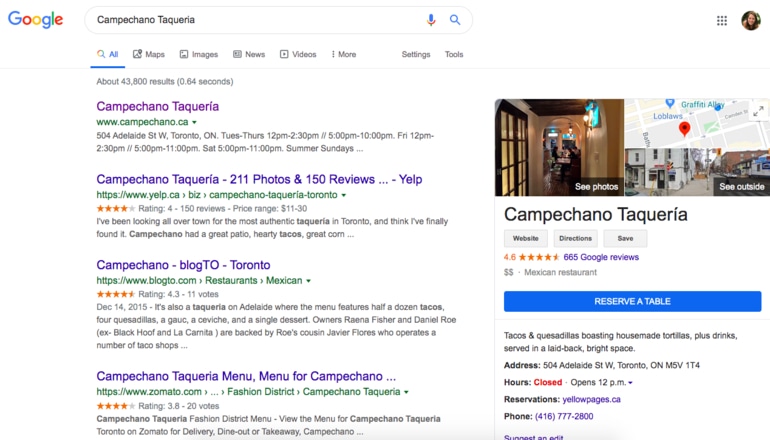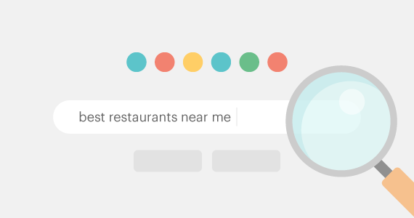Have you ever wondered how diners find your restaurant? Do they primarily rely on word of mouth? What about social media? Do they use search engines? And, if so, what restaurant searches do they use?
Word of mouth will always play a role in how customers find restaurants. But the rise of the Internet and modern technology has brought about a change: Guests now use multiple platforms to search for and make restaurant reservations.
If you want to stay ahead of the curve, you need to understand how guests discover new restaurants and what strategies you can use to show up in these restaurant searches.
In this post, you’ll learn:
- What platforms diners use to search for restaurants
- How exactly they search
- What strategies you can use to show up in restaurant searches
Restaurant Searches: How Diners Search for Restaurants
Diners use a variety of platforms to find a table:
- Search engines (e.g., Google or Bing)
- Consumer-facing restaurant reservation apps that help restaurant searchers discover restaurants near them and make reservations
- Review sites like Yelp or TripAdvisor
- Social media platforms like Facebook
And, when searching, diners typically search by many different criteria:
- Location: For example, restaurant searches by city
- Proximity: Customers will use the terms “near me” in a Google search. In fact, although the vast majority of “near me” searches are done for several terms, including “post office near me” or “things to do near me,” “restaurants near me” has the largest organic search volume per month, with 6.2 million organic searches.
- Restaurant type: For example, fast food vs. fine dining restaurants
- Brand: Diners will search by name if they already know about you – maybe you were a referral, or perhaps they ate at your restaurant before
- Cuisine type: For example, Italian, Mexican, or even South African cuisine
Of course, people rarely use one platform and one set of criteria when searching. For example, a couple who plans a weekend getaway to New York City and wants an exceptional dining experience will probably search by location and restaurant type. A possible search term may be “the best fine-dining restaurants in Manhattan.”
These potential guests will probably also use review sites like TripAdvisor to find suitable restaurants in New York City. They’ll filter results based on criteria like “cuisine and dishes,” “dietary restrictions,” and “price.”

Beyond just showing up in Google search results, diners can actually book directly through the search platform, using Reserve with Google. Reserve with Google spans across industries, with the ability to reserve everything from tables to tickets. Reserve with Google gives diners a seamless reservation experience without ever having to leave their search.
What does the experience look like? First, diners search for a restaurant. If Reserve with Google is set up, a “reserve a table” button appears on the first result page. Diners can then click on the reserve button.

The diner is then taken to a menu where they select a date, time, and number of guests. Once they fill that in and click continue, an overview of the reservation pops up. Diners plug in their information or sign in directly through Google, click confirm, and voila! Their dinner reservations are locked in and they didn’t even have to open a new tab. With such a convenient booking method, it’s no wonder diners are turning to Google.

How to Show up in Restaurants Searches
Now that you know how guests search, what can you do to get found in searches?
The upcoming section shares two powerful ways. The first involves creating business profiles on the platforms and adequately optimizing them for searches. The second consists of building a mobile-friendly restaurant website and optimizing key pages for relevant keywords.
Let’s have a look.
1) Create Business Profiles and Optimize for Local Search
According to ReviewTrackers, local searches account for 35% of all searches on the Internet. And, as you saw, “restaurants near me” is one of the most common “near me” searches in Google – and also potentially very profitable.
Whenever a customer types this search query into Google, they’re immediately presented with three restaurants.
(Don’t believe us? Stop reading, open a new tab in your browser, and type in “restaurants near me.” See?)
If you can get featured in the top three, you will improve your chances of being clicked on from a restaurant search. But how exactly do you optimize for these local searches?
Here’s a step-by-step guide.
Step 1: Create Business Profiles on Major Directories
Start by creating business profiles on all the major directories: Google, Bing, Yelp, Facebook, Foursquare, Apple Maps, and TripAdvisor.
There are more search engines, mapping services, and review sites, but these are the major ones and will give you quick wins with minimal effort.
Step 2: Maintain Consistency Across Platforms
Then, make sure all your business information is consistent across platforms. If you don’t maintain consistency – with different addresses or even a different business name, for example – Google will probably penalize you.
So how do you achieve consistency? Do the following:
- Write down your essential business information in an Excel spreadsheet. This information includes your business address, phone number, operating hours, business name, website, and zip code.
- Refer back to this spreadsheet to check for accuracy as you complete all business profiles.
- Double-check to see that the information is correct across platforms.
- Add extra information that may be applicable, like whether your restaurant offers vegan food or has a kids’ play area. Including this information improves your chances of ranking for various related search queries in Google. For example, a family may search for “restaurants with a kids play area near me.” Because you’ve included these terms, your restaurant now appears for that search.
- Include high-quality photos of your restaurant. Low-quality ones will only reflect poorly on your brand.
Step 3: Manage Your Reviews
You’ll also have to monitor, manage, and respond to the reviews on the various platforms. Why? Your review scores, the volume of reviews, and how quickly you respond to them are all ranking factors that determine how you rank for local search.
Here are a few tips for better review management:
- Encourage customers to leave reviews so you can steadily build reviews over time. You obviously don’t want to “bribe” customers into leaving a review. But, there are subtle ways to encourage them to leave one. For example, put signage at the front of your restaurant that asks customers to leave a review on TripAdvisor or Google if they enjoyed their dining experience.
- Reply to all reviews, including negative ones, as quickly as possible. Google looks favorably upon those companies that respond quickly. Admittedly, you cannot be in front of your computer 24/7. But you can delegate this task to someone – maybe someone who handles social media at your restaurant.
2) Build a Website and Optimize It
If you don’t already have a website, we strongly recommend you make one. After all, a restaurant website:
- Increases your online exposure
- Helps you get found in search engines
- Is an extension of your customer experience – a website should reflect and enhance the experience at the restaurant itself
- Provides guests with information about your restaurant, which helps them decide whether (or not) to eat there – this includes prices, the food you serve (menus), and where you’re located
Of course, to realize these benefits, you need to build your website the right way. The upcoming section shares three steps to create a stunning website and a few best practices for getting found in search engines.
3 Simple Steps to Create a Website
Note: This section does not cover website design in detail – learn more about it here.
Step 1: Prepare
Get organized, browse other sites online for inspiration, decide on the layout and the types of pages you’ll have (about, home, contact me, etc.), and gather materials. Materials include your website copy, menu, and design elements. Finally, map out your site by opening a notebook and roughly sketching how you want each page to look.
Step 2: Build
With the building blocks out of the way, you can create. You’ll need the following to start building:
- Website builder (e.g. Squarespace and Wix – these platforms will help you build a site without coding)
- A theme. This is the starting template you’ll use for your designs. Select a theme that has the features you want (e.g. a menu). Because Squarespace and Wix already have restaurant templates with all those features, consider going with them.
- A domain name (e.g. yourrestaurantname.com). Keep the domain name short and simple to avoid people misspelling and not being able to find your website. Do some research to see if the name you want is available, ideally with a .com extension, since it’s the most well-known and recognized. The site whois.net can help you see if your domain name is available and – if it’s not – give you info on who owns it. You may be able to convince them to sell you the domain name.
- Reservations widget. You want people to be able to book reservations directly on your website, so make sure you include the booker integration. Your reservation management platform can help you set this up.
Step 3: Publish
After you’ve completed your website design and checked your copy, it’s time to go live. Have friends and family on call when you do, so they can explore the site, test your reservations booker, and make sure everything’s working properly.
Website SEO Best Practices
1. Create a Mobile Responsive Website
A mobile-friendly website improves the user experience and ensures you capture traffic from those customers who search with mobile devices – and there are many, with numbers growing rapidly.
In fact, research suggests that smartphone search queries have increased from 27% in 2013 to close to 60% in the first quarter of 2019, with growth in the restaurant industry, especially rampant.
For example, a study by SinglePlatform mentions that “81% of consumers have searched for a restaurant on a mobile app and 92% through a web browser in the last six months, outperforming other highly searched industries, such as entertainment, retail outlets, hotels, and personal services.”
Mobile-friendly websites also rank higher in Google, which means you show up on more searches and hopefully get more customers.
Note: If you use Wix or Squarespace, your website will automatically be mobile responsive.
2. Optimize Your Website for Speed
If a website takes more than three seconds to load, 40% of people will leave. This means you need to concentrate on reducing page load time. You can do this by:
- Reducing the number of plugins and using lightweight plugins where necessary
- Compressing images and videos before uploading as large files take longer to load
3. Choose the Right Keywords
Finally, you need to select relevant keywords customers use to find your restaurant and optimize your website pages for these keywords. Again, an excellent place to start is to focus on local search terms that also incorporate the type of restaurant you are or even the type of food you serve.
If, for example, you run a vegan restaurant in Chicago – it makes sense to optimize a website page for the keyword “vegan restaurants in Chicago,” “veggie grill Chicago,” “fancy vegan restaurants Chicago” or even “best vegan places in Chicago.” And no, I’m not making these restaurant searches up – Google Keyword Planner reveals that these are actual terms people use to discover vegan restaurants in Chicago.
See below:

For more detail on getting found in restaurant searches and Google, read How to Win at the Google Game: SEO & SEM for Restaurants.
3) Optimize Your Restaurant’s Presence on Your Reservation App
If you use a third-party reservation management software, like TouchBistro Reservations, you probably also have access to their consumer-facing app where diners can search and book reservations directly.
Here are a few tips for making the most of your profile on these apps:
- Restaurant description: Write a description of your venue, including the type of food you serve, the atmosphere, your special or notable dishes, and more. But, keep it short and sweet. Remember than many people will be looking at your profile from a phone screen, so the less scrolling they have to do, the better.
- Tags: Set up appropriate labels or “tags” for your restaurant that will help the app recommend your restaurant to diners searching for your venue type, food type, and location.
- Location: People need to know where you are, but you can also include a map or special parking instructions.
- Photos: Like your website and business profile, you want these photos to be high-quality, accurate, and mouth-watering.
- Availability: Everything from the days you’re open (and taking reservations), to the times, and party numbers guests can book. Some restaurants like to personally manage tables larger than six, so make sure to customize your range for online bookings and let people know how they contact you for larger or more specialized reservations.
- Reviews: Like you did with other directories, you’ll want to monitor any reviews you get on your reservation platform. Some reservation platforms, like TouchBistro let you manage, respond to, and remove negative reviews that submitted by customers.
- Advertising: Some reservation apps let you purchase advertising or boosted results that let you appear at the top of relevant searches on the app. If you’re new to reservations and trying to use this platform to get new customers, this might be an option for you.
The Bottom Line on Showing up in Restaurant Searches
Today, consumers are using a variety of platforms to find restaurants, including reservation apps, review sites, and search engines.
Although consumers do interact differently with these platforms, they’re invariably using specific terms and common criteria to search like location and cuisine type.
As a restaurant owner, it’s your job not only to understand how they search but also how you can capitalize on these restaurant searches. This post explored two ways:
- Create business profiles across the core platforms while ensuring that information is consistent across platforms.
- Build a mobile-friendly restaurant website that’s optimized for the right keywords.
- Make the most of your reservation app’s restaurant profile, so you appear in more searches, entice more customers, and provide a better customer experience.
Have you used any of these methods to show up in restaurant searches? What was your experience?
Free social media templates for your restaurant
Sign up for our free weekly TouchBistro Newsletter







